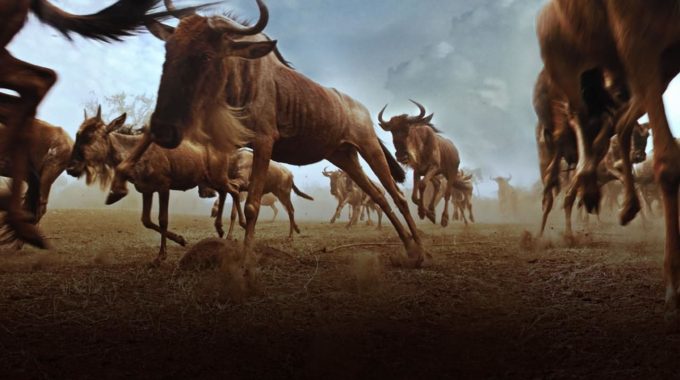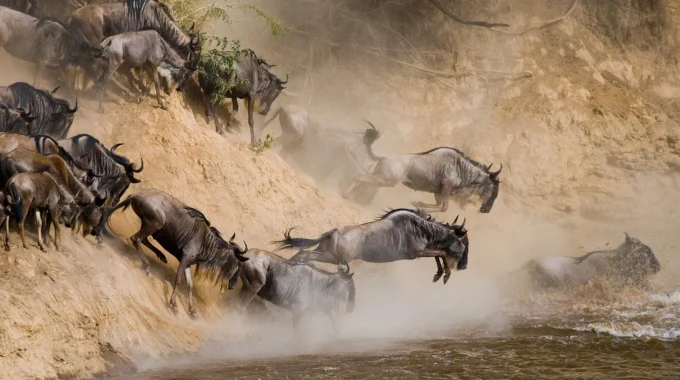A Kenya safari cost can vary significantly based on several factors, such as the season,…
What is the main reason confronting wildebeests during migration?
What is the main reason confronting wildebeests during migration? –
During their annual migration in Kenya and Tanzania, wildebeests (gnus) face numerous challenges, with the main reason being the perilous journey across the Serengeti-Mara ecosystem, characterized by natural obstacles, predators, and environmental factors. Below is a detailed breakdown of the main challenges wildebeests confront during migration:

1. River Crossings and Drowning Risks
One of the most significant threats during the wildebeest migration is crossing the Mara River in the Serengeti-Mara ecosystem (Kenya and Tanzania). Wildebeests face the following risks:
- Predation by Crocodiles: The Mara River, known for its large population of crocodiles, presents a deadly hazard for the wildebeests. Crocodiles lie in wait for the migrating herds to cross, and many wildebeests fall victim to them, especially weaker or slower individuals, including calves and old animals.
- Strong Currents and Drowning: During the migration, the river can swell due to seasonal rains, increasing the strength of its current. This makes the crossing even more treacherous, and many wildebeests, especially young or injured ones, drown or are swept away.
2. Predation by Lions, Hyenas, and Other Carnivores
Throughout the migration, wildebeests face constant pressure from predators such as:
- Lions: The lion prides in the Serengeti and Maasai Mara ecosystems have evolved to take advantage of the migratory herds. Lions often target weak, young, or isolated wildebeests. They typically hunt in coordinated groups, ambushing animals and using the cover of tall grasses to stalk prey.
- Hyenas: Hyenas are opportunistic scavengers and hunters. They follow the migration and often prey on wildebeests, especially those that are injured or separated from the herd.
- Cheetahs and Leopards: While cheetahs typically target the younger, faster wildebeests, leopards also pick off individuals from the herd, particularly during the day when the herds might be more scattered.
3. Food and Water Scarcity
Wildebeests must constantly move in search of food and water. During their migration between the Serengeti and Maasai Mara, they face the challenge of finding sufficient resources to sustain them. These challenges include:
- Grass Availability: The timing of the migration is crucial to ensure access to fresh, nutritious grass. However, dry seasons or delayed rains can lead to periods of food scarcity, weakening the wildebeests and making them more vulnerable to disease and predators.
- Water Sources: In addition to food, water is essential for wildebeests’ survival, especially in areas where rivers are dry or water sources are limited. The availability of water fluctuates, and the wildebeests may have to cross large distances, further depleting their energy reserves.
4. Disease
As the wildebeest herds travel in such large numbers, they become susceptible to diseases. The primary challenges include:
- Outbreaks of Disease: Diseases like Rinderpest, Anthrax, and Foot and Mouth Disease are common among wildebeest populations during migration, especially in densely packed herds. These diseases can spread rapidly, weakening the herds and causing mortality.
- Parasites and Infections: Wildebeests are also susceptible to ticks, flies, and other parasites, which can cause illnesses like tick-borne fever. The overcrowding of the herds during migration increases the risk of infection.
5. Environmental and Climate Challenges
- Seasonal Rain and Flooding: The timing of the rains is critical for the migration. In years of delayed or insufficient rainfall, the wildebeests may struggle to find food and water. Flooding from heavy rains can further complicate river crossings and increase the risk of drowning or injury.
- Temperature Extremes: Wildebeests face extreme temperature variations, especially during the dry season when the sun can be intense and exhausting. Prolonged heat can dehydrate them and leave them vulnerable to exhaustion, which increases their chances of falling behind the herd and becoming prey to predators.
6. Loss of Habitat and Human Activity
- Human-Wildlife Conflict: As human populations in Kenya and Tanzania grow, wildlife corridors are increasingly impacted by agriculture, settlements, and tourism development. Wildebeests may find their migratory routes blocked, reducing access to feeding grounds and water sources. Additionally, increased human activity around key migration areas, like the Maasai Mara National Reserve in Kenya, can cause disturbances to the migration, leading to changes in the timing or paths taken by the wildebeests.
7. Genetic Bottlenecks and Overcrowding
In some areas of the migration, such as the Mara River crossings, overcrowding can occur, especially when the wildebeest herds become too large for the available space. This leads to a higher likelihood of disease spread, increased predation, and exhaustion among the herds. Moreover, the genetic diversity of the wildebeest populations can be impacted by migration-related bottlenecks, where a limited number of individuals successfully cross critical points, affecting the long-term survival of the species.
Conclusion
The wildebeest migration in Kenya and Tanzania is a remarkable phenomenon driven by the search for food, water, and suitable breeding conditions. However, it is fraught with numerous challenges that include dangerous river crossings, predation, disease, food and water scarcity, and environmental hazards. Despite these challenges, the migration continues to be a vital survival strategy for the species, ensuring the dispersal of the herds across vast areas of the Serengeti and Maasai Mara ecosystems.



